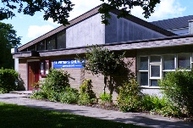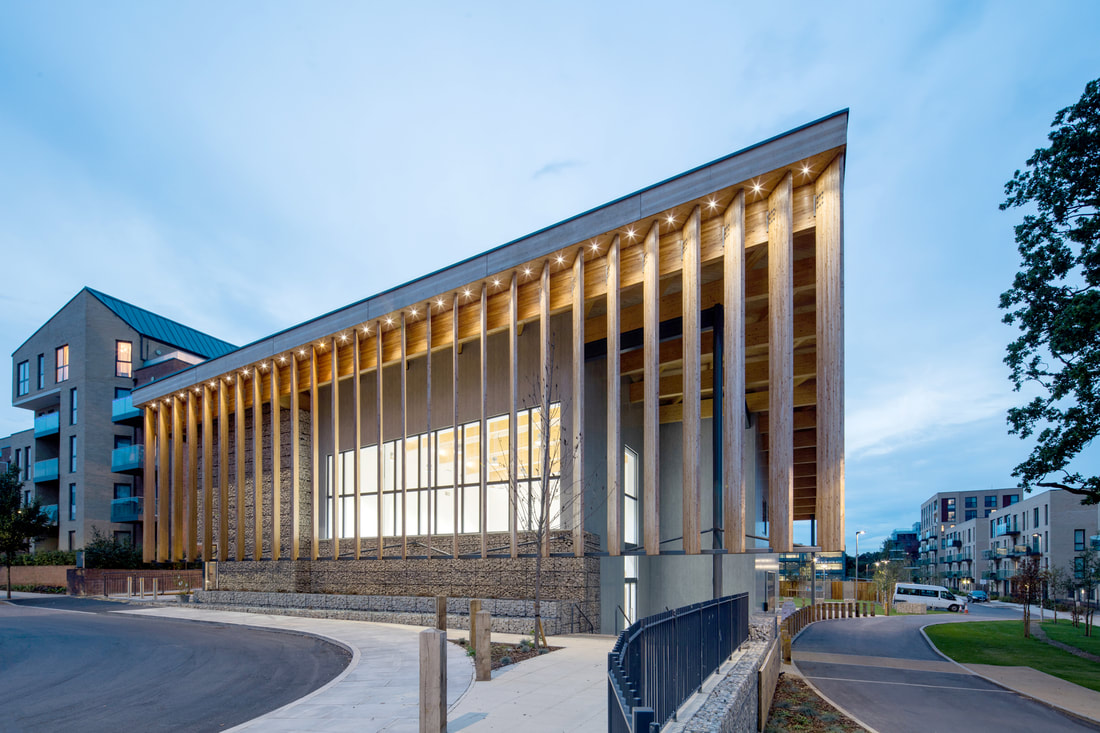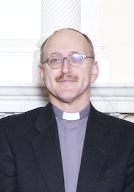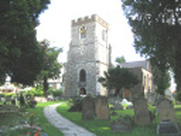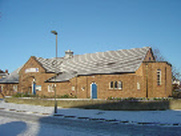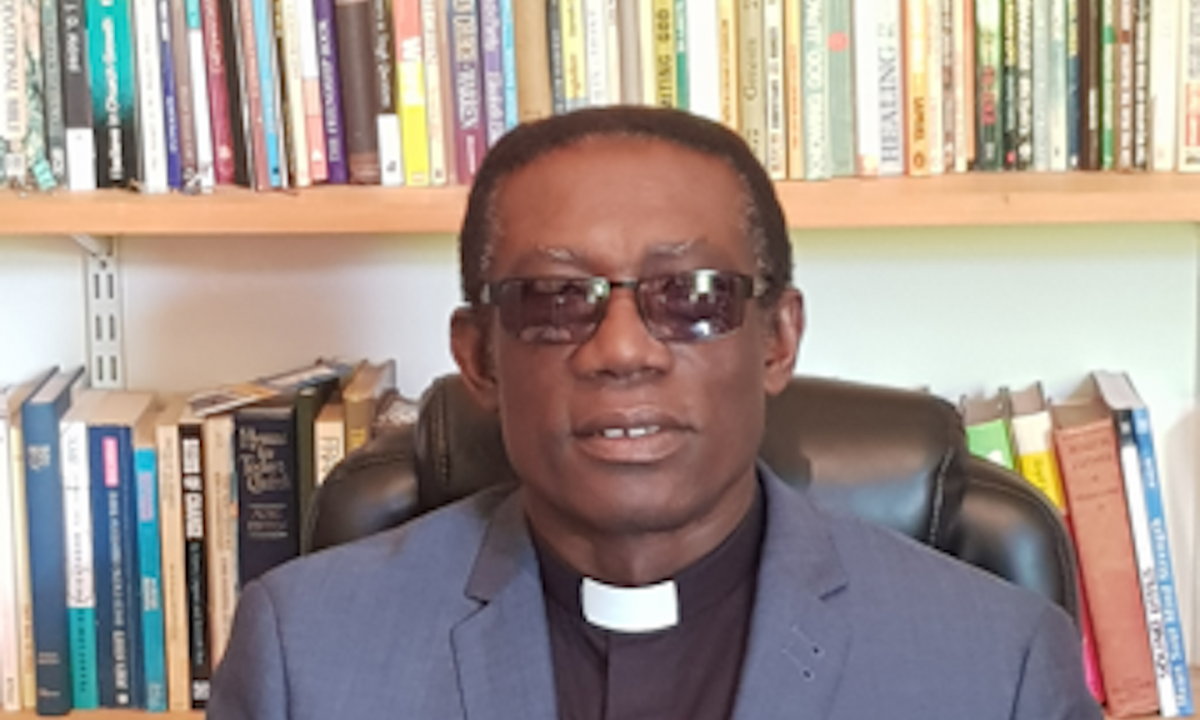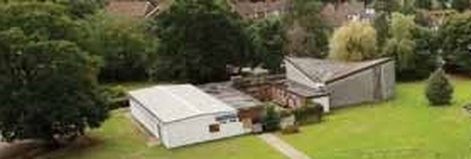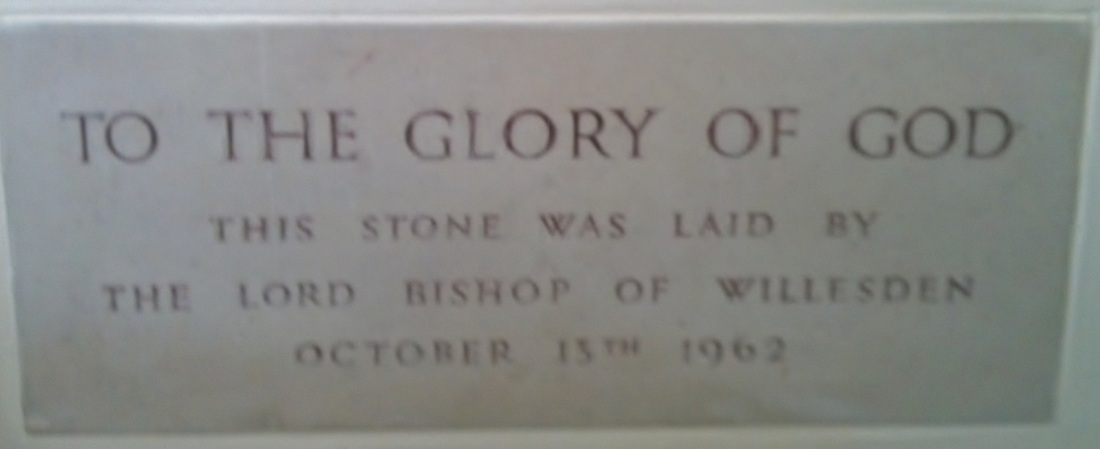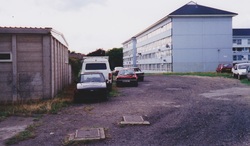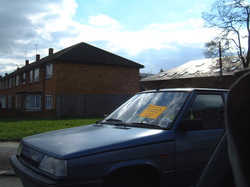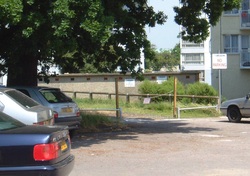1962 50th. Anniversary 2012
History Board
History Board(1962 – 2014)
Welcome to St. Peter’s history board this has been put together to celebrate its fiftieth anniversary and beyond.
St. Peter’s was planted by St. Margaret’s Edgware, as a mission church to serve the new Stonegrove Estate being built at the north of Edgware at the end of the A5 in 1962.
St. Peter's Church Stonegrove
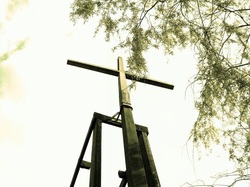
St. Peter’s Community Church belongs to the wider team of Anglican churches in Edgware as part of the Edgware Team Ministry, and, beyond that, to the
Diocese of London.
The Edgware Team Ministry is made up of 3 Edgware churches, St. Margaret’s, Station Road, Edgware.
St. Andrews, Broadfields, & St. Peter’s, Stonegrove.
Our 3 churches meet in different buildings but we share the same roots in Jesus, the same commitment to growing closer to Him and each other through our worship and weekday activities and the same desire to engage with the needs of the local area and beyond.
Diocese of London.
The Edgware Team Ministry is made up of 3 Edgware churches, St. Margaret’s, Station Road, Edgware.
St. Andrews, Broadfields, & St. Peter’s, Stonegrove.
Our 3 churches meet in different buildings but we share the same roots in Jesus, the same commitment to growing closer to Him and each other through our worship and weekday activities and the same desire to engage with the needs of the local area and beyond.
TEAM EDGWARE (2013)
Team Vicar since 2008 Vacancy since 2021 Team Rector since Dec. 2018
More details of the team and the three churches can be found at: http://www.edgwareparish.org
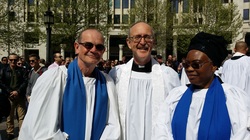
St. Peter's Ministry Team L-R Dave Franklin Licensed Lay Minister (Reader), Revd. Simon Rea Pioneering Minister to St. Peter's and Julie Okpala Licensed Lay Minister (Reader).

St. Peter's supporting the Diocese of London's Capital Vision 2020 initiative
|
Where to find us.
Bus: 142 (Walk down Lacey Drive) Tube: Edgware (15mins) Stanmore (15mins) Sat-Nav info HA8 8BN |
St. Peter's Community Church, Stonegrove.
Curates-in-charge of St. Peter’s Church (Since its beginning)
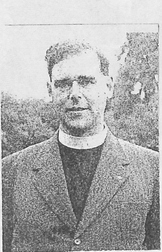
1961 - Charles Patrick Claridge
1966 - 1972 Robert James Law
1973 - 1976 Gerald Alfred Paddock
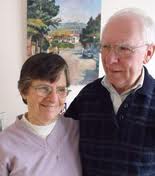
1977 - 1982 Peter Harry Jordan (and wife Barbara)
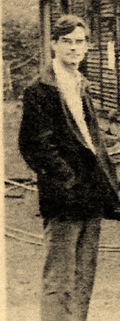
1983 - 1986 Robert Adrian Lens Van Rijn
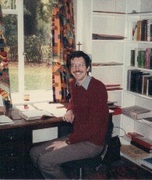
1986 - 1989 Robert William Wall
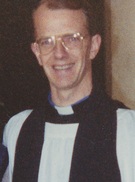
1989 - 1995 John Fairbairn
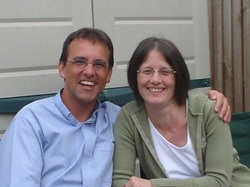
1995 - 2001 Robert John Powell Curate - Associate Team Vicar
Rob was the first minister to become an Associate Team Vicar
at St. Peter's
After Rob Powell left St. Peter's our Parish faced a triple interregnum which meant that all three churches in the Edgware Parish were without a minister. The parish was run by the Parochial Church Council and the District Church Council and the Churchwardens. 2001 - 2003
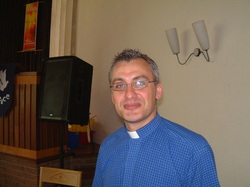
2003 - 2007 Peter Cooper Curate in training
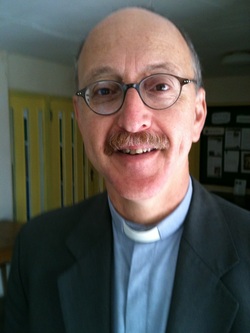
2008 - Simon William John Rea Pioneering minister.
(For a few years now St Peter’s has been actively at the heart of the community in Stonegrove, providing prayer, space and volunteers in one of London’s most deprived areas.
The work of the church was acknowledged by the provision of vital funding from the Bishop of London’s Mission Fund for the post of Pioneer Minister on the estates).
On 10th. August 2008 St. Peter’s got a proper vicar. St Peter's Edgware in Stonegrove received a £90,000 grant from the Bishop of London's Mission Fund (BLMF), which supports church projects across the Diocese of London.
The church received a second BLMF grant in 2010 (unprecedented) and this new funding provides much-needed support for the day-to-day operation of the church, enabling it to continue to play an active role in the local community over the next three years, in one of London's most deprived areas.
This importance of this post has been recognised as it has now been made permanent and is being paid for out of the LDF.
‘See I am doing a new thing! Now it springs up; do you not perceive it?’
(Isaiah 43:19)
How it all began
‘Melville’s Memoirs’
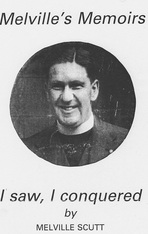
Reverend J Melville Scutt (Rector of St. Margaret’s Church, Edgware from 1949 – 1960)
Custard Pies???

Outside EdgwareChurch there stood throughout the month of October 1959 each weekend a large Elizabethan oak chest into which passers-by were invited to cast coins or other monies. Why was it there?
A few months earlier a notice had appeared in the Parish Magazine stating that two projects were under consideration: The repair of the Ancient Tower and The Building of a
new Church to cater for the large number of residents expected on a new housing estate of high rise flats.
Reading of this, Bill Evans, who was then living in Branksome Park, Bournemouth, having moved from his home in Mill Hill a few years before, rang the Rectory one morning.
On answering, I heard a voice, inviting me to come and see him in his London office.
A day was fixed, and it was a very excited man who climbed the stairs leading to a plush thick carpeted room, where he was welcomed by the Director, who had only recently retired from being Managing Director of Challen’s Pianos. After a full half hour of small talk, Bill Evans said: “Let
me tell you a story. When I was a young boy, I was very fond of custard pies; one day, being confined to bed with a feverish cold, and being told by my mother that God always hears us when we talk to Him, I asked Him to give me a custard pie.
I don’t think that I really expected Him to answer the prayer of a not to religious ten year old; but the fact is that it was not long before there was a ring at the front door and there stood our next door neighbour holding a plate of delicious hot custard pies; God had heard and answered me, my eyes lighting up when my mother came into my room with one or two of these dainties.
I then made a resolution that I have never broken, namely, that as God has been so good to me, I would give Him one penny out of every ten pennies I earned.
Yes, Rector, you may well say it was an emotional response of a young boy, who had been given something he badly wanted, who would very soon forget all about it.
The fact is though that when I started work, I gave away one tenth of my first week’s wages and that ever since, I have always set aside one tenth of my income, so that I could give it to some worthy cause. Now
tell me about your projects.”
A few months earlier a notice had appeared in the Parish Magazine stating that two projects were under consideration: The repair of the Ancient Tower and The Building of a
new Church to cater for the large number of residents expected on a new housing estate of high rise flats.
Reading of this, Bill Evans, who was then living in Branksome Park, Bournemouth, having moved from his home in Mill Hill a few years before, rang the Rectory one morning.
On answering, I heard a voice, inviting me to come and see him in his London office.
A day was fixed, and it was a very excited man who climbed the stairs leading to a plush thick carpeted room, where he was welcomed by the Director, who had only recently retired from being Managing Director of Challen’s Pianos. After a full half hour of small talk, Bill Evans said: “Let
me tell you a story. When I was a young boy, I was very fond of custard pies; one day, being confined to bed with a feverish cold, and being told by my mother that God always hears us when we talk to Him, I asked Him to give me a custard pie.
I don’t think that I really expected Him to answer the prayer of a not to religious ten year old; but the fact is that it was not long before there was a ring at the front door and there stood our next door neighbour holding a plate of delicious hot custard pies; God had heard and answered me, my eyes lighting up when my mother came into my room with one or two of these dainties.
I then made a resolution that I have never broken, namely, that as God has been so good to me, I would give Him one penny out of every ten pennies I earned.
Yes, Rector, you may well say it was an emotional response of a young boy, who had been given something he badly wanted, who would very soon forget all about it.
The fact is though that when I started work, I gave away one tenth of my first week’s wages and that ever since, I have always set aside one tenth of my income, so that I could give it to some worthy cause. Now
tell me about your projects.”
Church Tower or New Church?
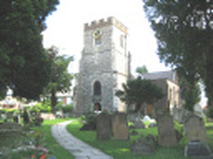
“Well”, I replied, showing not a little excitement in my voice, for
though when I entered the office, I expected to leave, if lucky,
with a fiver, I now confidently expected a much larger gift. “Edgware’s Church Tower is in great need of repair; in addition, many of us feel that we must cater for the needs of our rapidly increasing population by building a new church for them.”
“I’m not interested in old buildings,” he interrupted, changing his tone as he perceived how downcast I appeared to be by this remark, but I am keenly alive to the spiritual needs of people. Can you tell me how much the site for your proposed church will cost?”
I hesitated before answering, for I had not thought that far, never dreaming that the question
would be asked at such an early stage in our planning. At length I replied,“About £1500, I would think, but I’m really only guessing.”
“All right,” he answered, without hesitation, “I will give you a cheque for that amount.” Needless to say, I left that office overjoyed, so that when a few days later I presented the money to my
Churchwarden, Stanley Liddelow, at the weekly Parish PRAYER Meeting, we all sang with great feeling the Doxology, praising God from Whom all blessings flow.
Two months later, the wealthy Director again contacted me, inviting Elsie and me to his lovely home in Branksome Park. We were taken out to a delicious meal at a nearby Hotel, after which we chatted about the Church Building Fund.
“How is the Fund going?” he asked, expecting to hear something startling; but when the answer that came from my mouth was: “We’ve now reached about £4000”, he said impatiently “That’s not good enough, you ought to have far more by now,” adding “If you will have a special effort during October, I will double what you raise, up to £5000.” This was a challenge that I without hesitation accepted.
though when I entered the office, I expected to leave, if lucky,
with a fiver, I now confidently expected a much larger gift. “Edgware’s Church Tower is in great need of repair; in addition, many of us feel that we must cater for the needs of our rapidly increasing population by building a new church for them.”
“I’m not interested in old buildings,” he interrupted, changing his tone as he perceived how downcast I appeared to be by this remark, but I am keenly alive to the spiritual needs of people. Can you tell me how much the site for your proposed church will cost?”
I hesitated before answering, for I had not thought that far, never dreaming that the question
would be asked at such an early stage in our planning. At length I replied,“About £1500, I would think, but I’m really only guessing.”
“All right,” he answered, without hesitation, “I will give you a cheque for that amount.” Needless to say, I left that office overjoyed, so that when a few days later I presented the money to my
Churchwarden, Stanley Liddelow, at the weekly Parish PRAYER Meeting, we all sang with great feeling the Doxology, praising God from Whom all blessings flow.
Two months later, the wealthy Director again contacted me, inviting Elsie and me to his lovely home in Branksome Park. We were taken out to a delicious meal at a nearby Hotel, after which we chatted about the Church Building Fund.
“How is the Fund going?” he asked, expecting to hear something startling; but when the answer that came from my mouth was: “We’ve now reached about £4000”, he said impatiently “That’s not good enough, you ought to have far more by now,” adding “If you will have a special effort during October, I will double what you raise, up to £5000.” This was a challenge that I without hesitation accepted.
The 'War Chest'
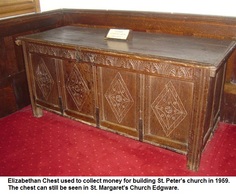
In Edgware there was a large oak chest, dating back to reign of Queen Elizabeth 1.
It was decided that every Saturday during October this chest would be taken outside the church. Beside it was a large sign, urging folk to give generously. While a scoreboard indicated the progress of the total which was changed every fifteen minutes, I stood nearby watching
and praying, as passerby cast their gifts into the chest. At first the going was slow, for though money was placed in the chest all through the day, there were no large contributions, so that the total collected over the first part of the month was far short of the target.
It was decided that every Saturday during October this chest would be taken outside the church. Beside it was a large sign, urging folk to give generously. While a scoreboard indicated the progress of the total which was changed every fifteen minutes, I stood nearby watching
and praying, as passerby cast their gifts into the chest. At first the going was slow, for though money was placed in the chest all through the day, there were no large contributions, so that the total collected over the first part of the month was far short of the target.
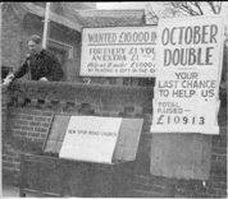
But God knew the need, so that, in response to the faithful requests of His people, who were custodians of His Bank Account, P.U.C. (Private Unlimited Company) during that month £7,000 were donated which, when added to the £5,000 promised by Mr.William Evans, resulted in an increase in the Building Fund of £12,000.
Living Church
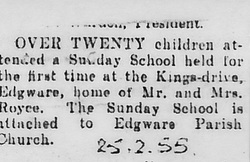
We had already begun the building of the ‘living’ church of St. Peter that is to say, not a church of bricks and mortar, but the church of human beings, for we now had an Evening Service in the new Edgware School, which had been newly built at Spur Road.
In addition a Home Bible Study Group was opened in Kings Drive at the home of Mr. and Mrs. Parrott, run by Naomi Ireland, our lady worker, and there was also a Sunday School.
In addition a Home Bible Study Group was opened in Kings Drive at the home of Mr. and Mrs. Parrott, run by Naomi Ireland, our lady worker, and there was also a Sunday School.
Dedication of Church Site
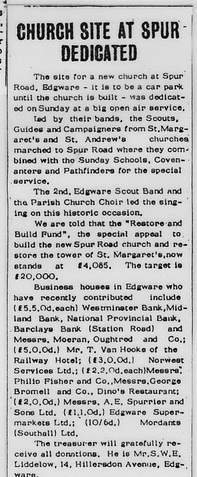
Soon a Service of Dedication on the proposed site for the new church was held, attended by a large congregation, and led by the 2nd. Edgware Scout Band.
Source: Autobiography of the Reverend Melville Scutt
(Rector of Edgware from 1949 – 1960)
Source: Autobiography of the Reverend Melville Scutt
(Rector of Edgware from 1949 – 1960)
A Church is born
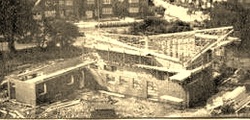
THE BIRTH OF ST. PETER'S CHURCH
|
When did St. Peter's Church really begin? Some will say 1962 when the Right Reverend the Bishop of Willesden laid and cemented in the foundation stone. This stone can still be seen to the left of the entrance Lobby.
Others will say it was when it was when the Church itself held a Service of Dedication on 13th. April 1963 at which the church was Dedicated by the Bishop of London The Rt Revd and Rt Hon Dr David Hope. 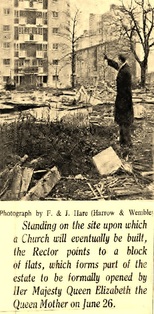
Still others would push the date back even further to 1958 when the proposed site was dedicated by the then Rector the Revd. J. Melville Scutt. (see report from the Parish Magazine below.)
The Service of Dedication of the Site at Spur Road for the church of St. Peter’s, Edgware
The Service of Dedication of the Site at Spur Road for the church of St. Peter’s, Edgware, took place in blazing sunshine, and a crowd of about eight hundred and fifty boys, girls, men and women gathered as a witness for the Lord Jesus and His Church in Edgware.
All branches of the Church were represented from St Margaret’s, St.Andrew’s and the Church at Spur Road. Many people, too in the tall blocks of flats sat out on their balconies to listen, and also joined in the service, as hymn sheets were taken up to them. The Rev. Mark Gunn led the service and the reading of the lesson was by Mr. Ken Griffiths. The reading from 1 Chronicles, chap. 29 which speaks of David’s declaration of God’s goodness to him, and also God’s promise that David’s son should build Him a House for His Worship. The Address was given by the Rector using the initials R & B (from our Restore and Build Appeal) as the symbols of his message Restore and Build, yes, and Repent and Believe also as the Rector put it. May we be given the grace to repent and BELIEVE that God can build a Church to His Glory at Spur Road; and also that we may claim His Promise from His Own Blessed Word that He will supply all our needs according to His Riches in Glory by Christ Jesus. Extract from The Parish Magazine (September 1959) (Continued from above) There are still others that would put the beginning date of St. Peter’s to before even the site Dedication in 1958. They would cite 1955 as the year the church began.That was the year when the seeds of the new ‘church’ were sown in the heart of Stan Parrott who had turned to Christ at the recent Billy Graham Crusade at Haringey. Stan and his wife had come to live in Kings Drive in one of the first houses to be built on the new Spur Road Estate. Worshipping at St. Margaret’s, Stan and his wife were concerned for the many children and the young families moving into Kings Drive, the flats had not yet been built. Rector Scutt encouraged a team of visitors to join him in visiting the area. Margaret Starns remembers the muddy, slushy state of Kings Drive, the pavements had not been laid, as they went from door to door with invitations for children to form a Sunday School in one of the houses. Phyliss Barwood was to be in charge. One Snowy February The grand opening was 20 February 1955. It was bitterly cold and it was snowing. As 2.30 approached no one had turned up – Phyllis thought that at least there would be the three Royce children –but then as she looked out at the door of the Royce’s home, she was full of praise as she saw a stream of children – some in ‘wellies’ – trudging through the snow (most had brought slippers to change into.) There were 16 children all together – crowded into a tiny room – and the first lesson was on the Christmas message – very appropriate in view of the weather – and was illustrated on a flannel graph. (Flannel graph (sometimes called a flannel board) is a storytelling system that uses a board covered with flannel fabric, usually resting on an easel. It is very similar to Fuzzy Felt, although its primary use is as a storytelling medium. The flannel board is usually painted to depict a background scene appropriate to the story being told. Paper cutouts of characters and objects in the story are then placed on the board, and moved around, as the story unfolds. These cutouts are backed, either with flannel, or with some other substance that adheres lightly to the flannel background, such as coarse sandpaper.) There was much fun and laughter with the little ones teaching them hymns and choruses without – at least in the very beginning – any musical accompaniment. The Sunday School grew – two weeks later there were as many as 25 children – and another home (Stan Parrott’s) and later on even a third home was opened up. Later on still the Sunday School was extended to include older children and moved into the Assembly Hall of the newly built Edgware School. Others involved with the Sunday school in those early days were Miss Naomi Ireland (who got married and became Mrs. Hughes) who was on the Parish staff, Phillip Barwood, Mrs. Dorothy Peacock and Miss Collins. Also involved was London City Missionary Keith Griffiths. (Source: Parish Magazine February 1980). In 1957/58 the Parish Church Curate the Revd. Ted Roberts had the remit to start evening Church Services in the newly built Edgware School it was then moved to the Community Centre. The London City Missionary Keith Griffiths was appointed to work as an evangelist /home visitor for the local area and he visited every home on the new estate. Two more Parish Church Curates continued the work before the Revd. Patrick Claridge was appointed as St. Peter’s first full time Curate-in-charge, moving into the new Parsonage just prior to the opening of the new Church building. From then until now we have had nine ministers who have served the Church, each with different gifts, each bringing skills to build St. Peter’s Church. 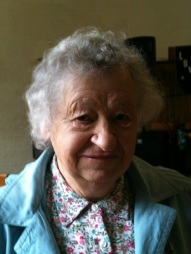
Margaret Starns is one of the founder members of St. Peter's. Memories of the early days of St. Peter’s by Margaret Starns |
The Church
The Spur Road ‘Church’ was up and running with a local congregation and a local church committee before the Church Building had been erected and this was due to planning, hard spade work and prayer beforehand.
The Spur Road ‘Church’ was up and running with a local congregation and a local church committee before the Church Building had been erected and this was due to planning, hard spade work and prayer beforehand.
Sunday School established 1st.
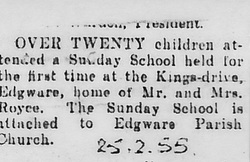
People from St. Margaret’s visited all the new homes and flats on the Estate recruiting for children to join the new Sunday School.
The first ones were to meet in two local homes in Kings Drive (Stan Parrott and Mr. Boyce both of whom became Christians with Stan going into full time ministry.) One recollection I have from when we were visiting the homes on the Estate was that although there were pavements the roads had not yet been finished with tarmac.
The first ones were to meet in two local homes in Kings Drive (Stan Parrott and Mr. Boyce both of whom became Christians with Stan going into full time ministry.) One recollection I have from when we were visiting the homes on the Estate was that although there were pavements the roads had not yet been finished with tarmac.

London City Mission
A London City Mission missionary, Keith Griffiths, was seconded on to Edgware Parish Church Staff for a three year contract to work on the Spur Road Estate (as it was known then.) This he did with energy and commitment, visiting every home on the Estate regularly. As a result the first church services started up in the Edgware School Hall led by Edgware Parish Church Curates, the first being the Rev’d. Ted Roberts, Doug and Peggy Berry were among the first regulars.
The Church then moved on to evening services in the Community Hall with the children’s Sunday School and ‘Pathfinders’ taking place on Sunday mornings and Campaigners using the Community Centre resources during the week.
When St. Peter’s Church was built and opened in 1962 Children’s groups continued to meet on Sunday mornings and church services in the evening ( An aside: A group from St. Margaret’s YPF formed a church choir so they were able to worship at St. Margaret’s in the morning, attend ‘Covenanters’ in the afternoon and attend St. Peter’s in the evening!)
A London City Mission missionary, Keith Griffiths, was seconded on to Edgware Parish Church Staff for a three year contract to work on the Spur Road Estate (as it was known then.) This he did with energy and commitment, visiting every home on the Estate regularly. As a result the first church services started up in the Edgware School Hall led by Edgware Parish Church Curates, the first being the Rev’d. Ted Roberts, Doug and Peggy Berry were among the first regulars.
The Church then moved on to evening services in the Community Hall with the children’s Sunday School and ‘Pathfinders’ taking place on Sunday mornings and Campaigners using the Community Centre resources during the week.
When St. Peter’s Church was built and opened in 1962 Children’s groups continued to meet on Sunday mornings and church services in the evening ( An aside: A group from St. Margaret’s YPF formed a church choir so they were able to worship at St. Margaret’s in the morning, attend ‘Covenanters’ in the afternoon and attend St. Peter’s in the evening!)
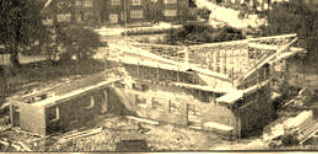
The building starts..............
Reverend. Patrick Clarridge
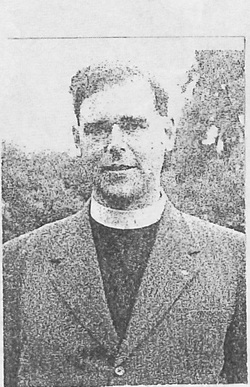
The Revd. Pat Clarridge was the first full time curate assigned to St. Peter's Church. He was also the first one to live in the Parsonage. (Another aside; Sadly he died of cancer after just 3 years of valuable work with us. St. Andrew's first curate also died after just three years there.)
A wooden Hall was acquired early on and erected with Local Council approval for three years, this approval had to be extended regularly. The 'Hall' remained in regular use until it burnt down in 1985. With the Hall being used this meant that services could be held in the church Sunday mornings and the children's could carry on at the same time in the Hall.
Under the inspirational work of the Rev'd. Gerald Paddock an extension consisting of a kitchen and a lounge which linked the Church and the Hall. Previously leaders and children had to brave the elements when they went to their groups.
From the earliest years a group of local peaople served on St. Peter's District Church Council which met in the Parsonage as did the Thursday Fellowship (Prayer and Bible Study) which later moved to the Lounge.
A wooden Hall was acquired early on and erected with Local Council approval for three years, this approval had to be extended regularly. The 'Hall' remained in regular use until it burnt down in 1985. With the Hall being used this meant that services could be held in the church Sunday mornings and the children's could carry on at the same time in the Hall.
Under the inspirational work of the Rev'd. Gerald Paddock an extension consisting of a kitchen and a lounge which linked the Church and the Hall. Previously leaders and children had to brave the elements when they went to their groups.
From the earliest years a group of local peaople served on St. Peter's District Church Council which met in the Parsonage as did the Thursday Fellowship (Prayer and Bible Study) which later moved to the Lounge.
Capt. Roger Murphy
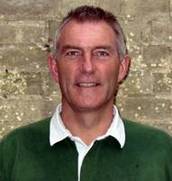
These are just the bare bones of what went on there was also a thriving Mother and Toddlers Group started by Jenny and Jean,
Wednesday Welcome with Ann Percival, Campaigners with Yvonne Downes, various Homegroups one of which was led by Roger Murphy who came to faith at St. Peter’s and went on to become a Church Army Captain and our first missionary.
Down through the years there have been Youth clubs, children’s and church missions only God knows the full worth of our work!
Wednesday Welcome with Ann Percival, Campaigners with Yvonne Downes, various Homegroups one of which was led by Roger Murphy who came to faith at St. Peter’s and went on to become a Church Army Captain and our first missionary.
Down through the years there have been Youth clubs, children’s and church missions only God knows the full worth of our work!
St. Peter’s Church (Dark clouds with silver linings.)
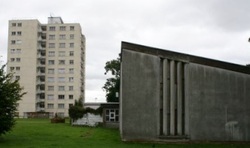
The distinctive shape of St. Peter’s owes its design to its link with Peter (the Disciple) the fisherman. The shape of the parabolic roof represents the hull of a boat in the way the roof is raised at the north and south end.
This theme is also reflected inside the church with the parabolic ceiling being completely covered with varnished pine tongue and groove. (good acoustics)
This theme is also reflected inside the church with the parabolic ceiling being completely covered with varnished pine tongue and groove. (good acoustics)
The Chancel
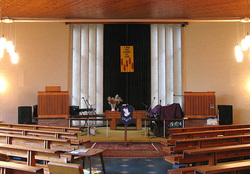
The chancel has a divided rail across and has a raised pulpit one side and lectern on the other side.
The seating area consisted of pine pews with a centre aisle. (Later removed and replaced by chairs during Peter Cooper's time.) The floor was concrete covered by linoleum floor tiles.
The wood theme is carried through with the Altar Table, the raised Pulpit, the Lectern and the Font.
The seating area consisted of pine pews with a centre aisle. (Later removed and replaced by chairs during Peter Cooper's time.) The floor was concrete covered by linoleum floor tiles.
The wood theme is carried through with the Altar Table, the raised Pulpit, the Lectern and the Font.
Built in the early sixties
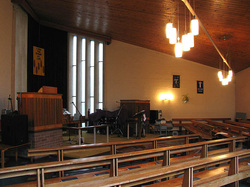
Being built in the sixties the building regulations weren’t as stringent as they are today and as such it has walls of single brick (no cavity wall) the strength of the structure is in a tensioning bar, just under the ceiling, that runs from the east to the west corner.
South West Wall
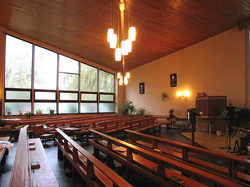
The south west wall is almost all covered by single glazed windows which brings in a lot of light.
As there is no gas supply the heating of the church relied on electric tube heaters running under the pews.
Because of the large windows the inside of the church got very hot during the summer.
Also because of the large single glazed windows, the high ceiling, the single brick built walls and the concrete floor the church was very cold during the winter months.
When the church was first built it didn’t have a church hall. A little later a large wooden hut was obtained and erected which now meant we could have Sunday School, Campaigners, Youth Club and other functions rather than go to the Community Centre or the Edgware School.
The only problem was it meant getting wet if it was raining as we went from the church to the ‘hut.’
In the mid seventies a foyer, a lounge, and kitchen was added to the end of the corridor where the toilets are, this joined the church to the ‘hut.’ No more getting wet or trudging through snow or mud.
The 'hut' / hall was well used not with just Sunday School and Campaigners and Youth Group but we also had a men's group and Mother and Toddlers and birthday parties etc.
This went on for just over ten years.
As there is no gas supply the heating of the church relied on electric tube heaters running under the pews.
Because of the large windows the inside of the church got very hot during the summer.
Also because of the large single glazed windows, the high ceiling, the single brick built walls and the concrete floor the church was very cold during the winter months.
When the church was first built it didn’t have a church hall. A little later a large wooden hut was obtained and erected which now meant we could have Sunday School, Campaigners, Youth Club and other functions rather than go to the Community Centre or the Edgware School.
The only problem was it meant getting wet if it was raining as we went from the church to the ‘hut.’
In the mid seventies a foyer, a lounge, and kitchen was added to the end of the corridor where the toilets are, this joined the church to the ‘hut.’ No more getting wet or trudging through snow or mud.
The 'hut' / hall was well used not with just Sunday School and Campaigners and Youth Group but we also had a men's group and Mother and Toddlers and birthday parties etc.
This went on for just over ten years.
Cracking up!(The 'gaffer tape didn’t work!)
Dave Franklin looks back
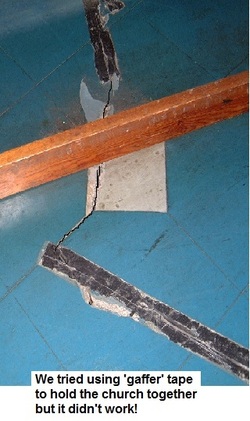
Ever since I started going to St. Peter’s in the early eighties there have been cracks in the floors and walls although these were not major.
It was in the nineties that the cracks got progressively worse and by the time the Rev'd. Rob Powell became our Curate they became quite serious. (It wasn’t because of Rob that the cracks got bigger I hasten to add there were several contributing factors);
The weather – dry hot summers and not much rain in the winters dried the clay soil up causing it to contract. Which pulled on the foundations.
Building regulations – as I said on an earlier page the building regulations in the early sixties weren’t as stringent as they are today.
Because of this the foundations were not as they should be. They weren’t deep enough and it is more usual to set the foundations on a concrete float in soft clay soil.
Trees – The close proximity of several large oaks and willow trees was taking moisture out of the soil.(Some of the willows were planted by a past curate as a nice backdrop for wedding photos etc.)
Drains – the drains around St. Peter’s because of the lack of soil moisture causing earth movement and tree roots had caused the drains to collapse.
It was in the nineties that the cracks got progressively worse and by the time the Rev'd. Rob Powell became our Curate they became quite serious. (It wasn’t because of Rob that the cracks got bigger I hasten to add there were several contributing factors);
The weather – dry hot summers and not much rain in the winters dried the clay soil up causing it to contract. Which pulled on the foundations.
Building regulations – as I said on an earlier page the building regulations in the early sixties weren’t as stringent as they are today.
Because of this the foundations were not as they should be. They weren’t deep enough and it is more usual to set the foundations on a concrete float in soft clay soil.
Trees – The close proximity of several large oaks and willow trees was taking moisture out of the soil.(Some of the willows were planted by a past curate as a nice backdrop for wedding photos etc.)
Drains – the drains around St. Peter’s because of the lack of soil moisture causing earth movement and tree roots had caused the drains to collapse.
Tell-Tale
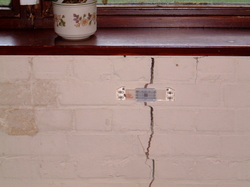
All of this meant that the cracks got wider and ‘telltales’ were fitted to the walls to monitor the movement. The floor in the north eastern corner of the church had sunk by as much as 2½ inches. We started to get really worried when we lost several small children we even had plans drawn up for open air services for when the wall fell down (only joking).
£250,000 I'm not joking
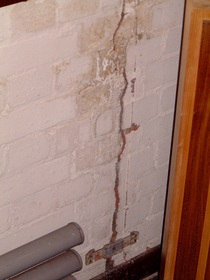
To put matters right and carry out repairs it was estimated that we would have to raise in excess of £250,000. This was an impossible sum to raise even if our three churches all pooled their resources.
We needed a miracle.
Our District Church Council (DCC) meetings and prayers meetings were now dominated by cracks and
drains.
We needed a miracle.
Our District Church Council (DCC) meetings and prayers meetings were now dominated by cracks and
drains.
Don't just sit there - pray something
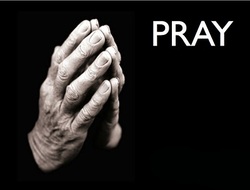
One particular prayer meeting where we had gathered in the Parsonage we had the plan of the church and its drains laid out on the floor and we all started praying. We were praying for our much needed £250,000 to miraculously appear.
The prayers were going around in a circle with some laying hands on the blueprint drawings as they prayed.
The prayers were half way round, I was near the end, it was one of those times when
everyone had all prayed the very same prayers I was going to pray. Panic set in as I sat there desperately thinking of a new way of saying the prayers that had already been said. It was then when I heard someone whisper in my ear “Stop praying for money and pray for a new church which will cost you nothing!”
I sort of half opened my eyes and squinted around to see who had said it but everyone
had their eyes tight shut and no one was looking in my direction.
I put it down to wishful thinking and closed my eyes again still trying to think of something to pray.
It was gradually getting closer to my turn to pray and there it was again “Stop praying for money and pray for a new church which will cost you nothing!.”
This ‘voice’ I kept hearing was overwhelming my thoughts.
It took a little while (being a bit dense) but eventually I realised this was not a
figment of my imagination nor was it wishful thinking but I was actually, yes me, I was actually hearing a message from God.
This was the first and only time I had heard a spoken message in that way. It was so clear and loud that I was convinced that everyone in that room should have heard it. But they didn’t it was just me. When I finally understood what was going on I started to
physically shake. In the meantime it was coming round to my time to pray my biggest fear now was that I wouldn’t be able to pray when it was my turn.
Well, it was now my turn and suddenly I felt really calm and I prayed something simple
something like. “Lord, we’re not asking for money we want a new church and one
we won’t have to pay for!” Then I felt the Holy Spirit move in that room and we all started praying for the same thing.
This tied in with a prophecy that Rob Powell brought with him to St. Peter’s which was from Joshua 1: 1-9. (I will give you every place where you set your foot,)
It seemed impossible at the time but God was promising us a new church building, one which He would provide.
The prayers were going around in a circle with some laying hands on the blueprint drawings as they prayed.
The prayers were half way round, I was near the end, it was one of those times when
everyone had all prayed the very same prayers I was going to pray. Panic set in as I sat there desperately thinking of a new way of saying the prayers that had already been said. It was then when I heard someone whisper in my ear “Stop praying for money and pray for a new church which will cost you nothing!”
I sort of half opened my eyes and squinted around to see who had said it but everyone
had their eyes tight shut and no one was looking in my direction.
I put it down to wishful thinking and closed my eyes again still trying to think of something to pray.
It was gradually getting closer to my turn to pray and there it was again “Stop praying for money and pray for a new church which will cost you nothing!.”
This ‘voice’ I kept hearing was overwhelming my thoughts.
It took a little while (being a bit dense) but eventually I realised this was not a
figment of my imagination nor was it wishful thinking but I was actually, yes me, I was actually hearing a message from God.
This was the first and only time I had heard a spoken message in that way. It was so clear and loud that I was convinced that everyone in that room should have heard it. But they didn’t it was just me. When I finally understood what was going on I started to
physically shake. In the meantime it was coming round to my time to pray my biggest fear now was that I wouldn’t be able to pray when it was my turn.
Well, it was now my turn and suddenly I felt really calm and I prayed something simple
something like. “Lord, we’re not asking for money we want a new church and one
we won’t have to pay for!” Then I felt the Holy Spirit move in that room and we all started praying for the same thing.
This tied in with a prophecy that Rob Powell brought with him to St. Peter’s which was from Joshua 1: 1-9. (I will give you every place where you set your foot,)
It seemed impossible at the time but God was promising us a new church building, one which He would provide.
The end of St. Peter’s Church?
(It’s getting darker but it aint dark yet!)
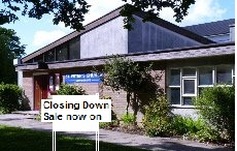
Whilst Rob was with us he was promoted to the lofty title of Associate Team Vicar.
Not long after that prayer meeting, Rob answered God’s call and moved on to pastures new. That in itself was pretty devastating to us at St. Peter’s but to make matters worse the Rector and the Team Vicar from St. Andrew’s also left. The Parish was now clergyless!
The three churches were being run by the Readers and churchwardens overseen by the PCC. The Revd. Paul Taylor the then Area Dean presided over the PCC’s and DCC’s.
It was at one of his meetings of the St. Peter’s DCC that he dropped two bombshells.
The Diocese had no money for a curate for St. Peter’s and our only hope would be to
get someone like a Church Army captain who was funded from elsewhere.
The other bombshell was that there was no money for repairing St. Peter’s and if the cracks got any worse the church would have to be demolished and the land revert back to the Council. Which would mean we would have to worship at St. Margaret’s or St. Andrew’s.
After that meeting all hope dissolved before our eyes. Maybe I had got it wrong at
that prayer meeting. Maybe the other prophecies were wrong!
I think it was at the following meeting or the one after that we saw a light at
the end of the tunnel.
Rita Bowden told the Committee she had heard a rumour that the Stonegrove had been
earmarked for a complete regeneration. (It certainly needed it!)
As time went on that rumour was confirmed and the regeneration of the area was going to happen. We began to pre-empt God (hindsight is a wonderful thing) maybe this was how God was going to provide us with the money to overhaul our church completely. After all we had a lot land around the church we didn’t use including the car park at the back of the church that was now a dumping ground for old cars.
We managed to get the cars removed, which had now become a health and an environmental problem. We negotiated with the Council who agreed to remove the cars for free as a one-off. We then put up a chain barrier to stop any further
dumping taking place.
Not long after that prayer meeting, Rob answered God’s call and moved on to pastures new. That in itself was pretty devastating to us at St. Peter’s but to make matters worse the Rector and the Team Vicar from St. Andrew’s also left. The Parish was now clergyless!
The three churches were being run by the Readers and churchwardens overseen by the PCC. The Revd. Paul Taylor the then Area Dean presided over the PCC’s and DCC’s.
It was at one of his meetings of the St. Peter’s DCC that he dropped two bombshells.
The Diocese had no money for a curate for St. Peter’s and our only hope would be to
get someone like a Church Army captain who was funded from elsewhere.
The other bombshell was that there was no money for repairing St. Peter’s and if the cracks got any worse the church would have to be demolished and the land revert back to the Council. Which would mean we would have to worship at St. Margaret’s or St. Andrew’s.
After that meeting all hope dissolved before our eyes. Maybe I had got it wrong at
that prayer meeting. Maybe the other prophecies were wrong!
I think it was at the following meeting or the one after that we saw a light at
the end of the tunnel.
Rita Bowden told the Committee she had heard a rumour that the Stonegrove had been
earmarked for a complete regeneration. (It certainly needed it!)
As time went on that rumour was confirmed and the regeneration of the area was going to happen. We began to pre-empt God (hindsight is a wonderful thing) maybe this was how God was going to provide us with the money to overhaul our church completely. After all we had a lot land around the church we didn’t use including the car park at the back of the church that was now a dumping ground for old cars.
We managed to get the cars removed, which had now become a health and an environmental problem. We negotiated with the Council who agreed to remove the cars for free as a one-off. We then put up a chain barrier to stop any further
dumping taking place.
Hope is rising
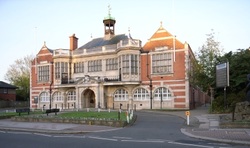
We found out that there was an open Council meeting taking place to discuss and answer questions about the proposed Regeneration Scheme. So one night a group of us turned up at Hendon Town Hall, the Burroughs, we were certain the council would jump at the chance of using some of our land and the money we would make could then go towards repairing
St. Peter’s or better still maybe St. Peter’s had been earmarked for regeneration with the surrounding area.
Could this be God’s way of giving us a new church?
We all sat patiently through all the preamble and finally it came to the time when the meeting was opened for questions. We were all on the edge of our seats when one of the councillors asked about St. Peter’s. The Chairman’s response was, “That insignificant little church at the corner of the estate? It has never been and never will be part of our plans for the Regeneration Scheme. (Gutted!) To say that our hopes were dashed is an
understatement.
After an architects quinquennial inspection we were told that he didn't expect the church to remain standing for another five years because of its poor state (It never rains but it pours).
St. Peter’s or better still maybe St. Peter’s had been earmarked for regeneration with the surrounding area.
Could this be God’s way of giving us a new church?
We all sat patiently through all the preamble and finally it came to the time when the meeting was opened for questions. We were all on the edge of our seats when one of the councillors asked about St. Peter’s. The Chairman’s response was, “That insignificant little church at the corner of the estate? It has never been and never will be part of our plans for the Regeneration Scheme. (Gutted!) To say that our hopes were dashed is an
understatement.
After an architects quinquennial inspection we were told that he didn't expect the church to remain standing for another five years because of its poor state (It never rains but it pours).
Stonegrove Estate before regeneration
Still looking for £250,000
We were supposed to be a dying church. A church without hope!
But we refused to die, and we did have hope! Our hope was in the Lord the maker of Heaven and Earth and our hope was in His unfailing promises.
What the planners and the leaders of the council didn't realise was that the Regeneration Scheme was part of God's plan for St. Peter's. So when the London Academy used up more land than originally planned for, the planners needed more land the only spare land available was here. Suddenly St. Peter's was no longer an insignificant little church. When they pulled down the Community Centre they needed somewhere to hold meetings and their exhibitions and somewhere to house the new Children's Centre, the only place available was here.
We’ve had Quinquennial Inspections since the time we were told the church wouldn’t last 5 years. And on 10th. August 2008 St. Peter’s got a proper vicar. St Peter's Edgware in Stonegrove received a £90,000 grant from the Bishop of London's Mission Fund (BLMF), which supports church projects across the Diocese of London.
The church received a second BLMF grant in 2010 (unprecedented) and this new funding provides much-needed support for the day-to-day operation of the church, enabling it to continue to play an active role in the local community over the next three years, in one of London's most deprived areas.
QUOTE:
Rob Warwick, Regeneration Manager for Family Mosaic, the new registered social landlord which is progressively taking over homes on the estates says:
"I am delighted that funding for Simon's post has been confirmed for another three years. He has been a key member of the Stonegrove Regeneration Partnership Board since coming to Barnet and I am looking forward to working with him on the Regeneration of the estate in the coming years."
But we refused to die, and we did have hope! Our hope was in the Lord the maker of Heaven and Earth and our hope was in His unfailing promises.
What the planners and the leaders of the council didn't realise was that the Regeneration Scheme was part of God's plan for St. Peter's. So when the London Academy used up more land than originally planned for, the planners needed more land the only spare land available was here. Suddenly St. Peter's was no longer an insignificant little church. When they pulled down the Community Centre they needed somewhere to hold meetings and their exhibitions and somewhere to house the new Children's Centre, the only place available was here.
We’ve had Quinquennial Inspections since the time we were told the church wouldn’t last 5 years. And on 10th. August 2008 St. Peter’s got a proper vicar. St Peter's Edgware in Stonegrove received a £90,000 grant from the Bishop of London's Mission Fund (BLMF), which supports church projects across the Diocese of London.
The church received a second BLMF grant in 2010 (unprecedented) and this new funding provides much-needed support for the day-to-day operation of the church, enabling it to continue to play an active role in the local community over the next three years, in one of London's most deprived areas.
QUOTE:
Rob Warwick, Regeneration Manager for Family Mosaic, the new registered social landlord which is progressively taking over homes on the estates says:
"I am delighted that funding for Simon's post has been confirmed for another three years. He has been a key member of the Stonegrove Regeneration Partnership Board since coming to Barnet and I am looking forward to working with him on the Regeneration of the estate in the coming years."
